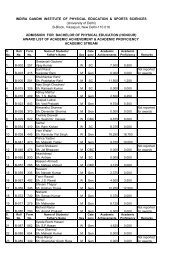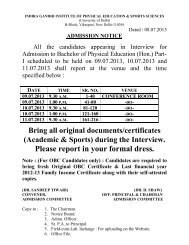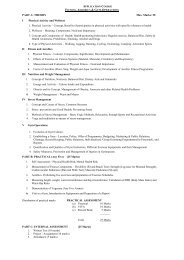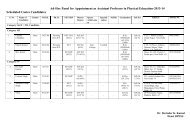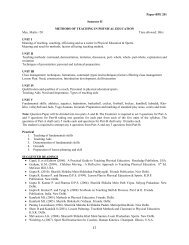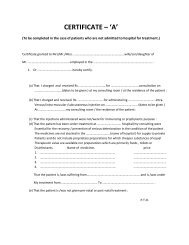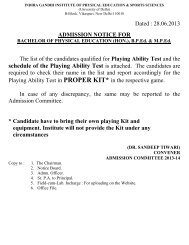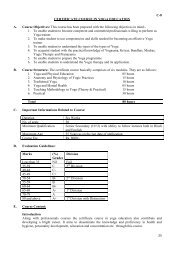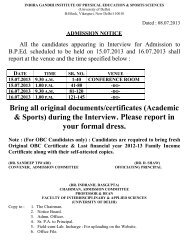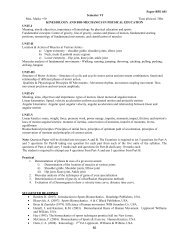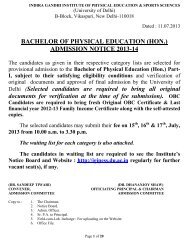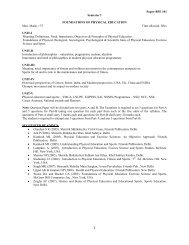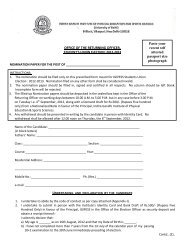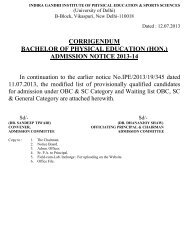Semester III - Indira Gandhi Institute of Physical Education and ...
Semester III - Indira Gandhi Institute of Physical Education and ...
Semester III - Indira Gandhi Institute of Physical Education and ...
Create successful ePaper yourself
Turn your PDF publications into a flip-book with our unique Google optimized e-Paper software.
Paper-BPE 303 (iii)<br />
<strong>Semester</strong> <strong>III</strong><br />
Max. Marks =50<br />
Time allowed: 3Hrs<br />
GAME OF SPECIALIZATION – BADMINTON<br />
UNIT-I<br />
Important motor components, Structure <strong>and</strong> process for improvement <strong>of</strong> performance, Various training methods <strong>and</strong><br />
principles <strong>of</strong> training load, Causes <strong>and</strong> symptoms <strong>of</strong> overload, Management <strong>of</strong> overload<br />
UNIT-II<br />
Anatomical considerations, Physiological considerations, Biomechanical considerations, Psychological<br />
consideration, Scientific research reviews<br />
UNIT-<strong>III</strong><br />
Long term <strong>and</strong> short term planning for competition, Cyclic process <strong>of</strong> training : micro, meso <strong>and</strong> macro cycles<br />
Preparation <strong>of</strong> training schedules, Tactical efficiency<br />
UNIT-IV<br />
Introduction, importance <strong>of</strong> test, measurement <strong>and</strong> evaluation in badminton, Fitness tests, Skill tests<br />
UNIT-V<br />
Means & methods, Teaching lessons, process <strong>of</strong> classroom teaching, Preparation <strong>of</strong> teaching lesson-plans :<br />
characteristics & principles, Stages <strong>of</strong> teaching, Use <strong>of</strong> teaching aids<br />
Note: Question Paper will be divided into two parts A <strong>and</strong> B. The Examiner is required to set 5 questions for Part-A<br />
<strong>and</strong> 5 questions for Part-B taking one question for each part from each <strong>of</strong> the five units <strong>of</strong> the syllabus. The<br />
questions <strong>of</strong> Part-A shall carry 5 marks each <strong>and</strong> questions for Part-B shall carry 10 marks each.<br />
The student is required to attempt any 4 questions from Part-A <strong>and</strong> any 3 questions from Part-B.<br />
PRACTICALS<br />
1. Practical applications <strong>of</strong> tactics <strong>and</strong> strategies<br />
2. Training means for development <strong>and</strong> measurement <strong>of</strong> strength, speed, endurance, flexibility <strong>and</strong> coordinative<br />
abilities<br />
3. Observing <strong>and</strong> assessing the video/tournament recording/movie <strong>and</strong> preparing a report<br />
4. Teaching lessons<br />
SUGGESTED READINGS<br />
<br />
<br />
<br />
<br />
<br />
<br />
<br />
<br />
<br />
<br />
Bloss M.V & Hales RS (1994). Badminton. WC Brown<br />
Downey J (1990). How to Coach Badminton. Collins Pub. London.<br />
Grice, T. (2007). Badminton : Steps to Success : 2 nd Ed. Human Kinetics, USA.<br />
Jain D (2001). Teaching <strong>and</strong> Coaching –Badminton. Khel S.K. Delhi<br />
Kumar A (2003). Badminton. Discovery, New Delhi.<br />
Narang P (2005). Play <strong>and</strong> Learn Badminton. Khel Sahitaya Kendra<br />
Seaman, J. (2009). Badminton Revisited. J.R. Books Ltd.<br />
Singh MK (2006). A to Z Badminton. Friends Pub. New Delhi.<br />
Singh MK (2007). Comprehensive Badminton. Friends Pub. New Delhi.<br />
Talbot Derlk (1989). Top Coach Badminton. Britain: Q.A. Press<br />
28



